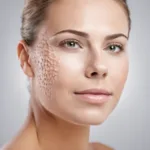10 January 2024
Discover how microneedling can transform your skin and address various skin concerns
In the quest for youthful and radiant skin, the beauty industry is constantly evolving with new treatments and procedures. One such innovation that has gained significant attention is microneedling. This minimally invasive cosmetic procedure, also known as collagen induction therapy, involves the use of tiny, sterilized needles to create micro-punctures in the skin. The process stimulates collagen production, leading to smoother, firmer, and more toned skin. In this article, we will explore the benefits, cost, efficacy, and safety of microneedling, as well as its targeted areas and how it compares to at-home rollers.
The Benefits of Microneedling
Microneedling has become increasingly popular due to its wide range of benefits. It is known to improve the appearance of scars, including acne scars, fine lines, and wrinkles. Additionally, it can reduce the size of enlarged pores and diminish hyperpigmentation, resulting in a more even skin tone. Microneedling also enhances skin elasticity and can even promote hair growth in individuals with alopecia. Compared to laser therapy, microneedling is often preferred by those with darker skin tones, as it carries fewer risks of skin pigmentation issues.
Targeted Areas for Microneedling
While microneedling is commonly performed on the face, it can also be used to address scarring and stretch marks on other parts of the body. Research has shown its effectiveness in treating stretch marks on the thighs and abdominal area when combined with fillers. Dermatologists have successfully used microneedling to improve the appearance of scars and stretch marks in various areas, providing patients with renewed confidence and smoother skin.
The Cost of Microneedling
The cost of microneedling can vary depending on the treatment needed and the professional performing the procedure. Estimates suggest that a session can range from $200 to $800, with lighter sessions costing around $150. Insurance typically does not cover microneedling, as it is considered a cosmetic or aesthetic procedure. However, some clinics may offer financing or payment plans to make the treatments more affordable. It’s important to consider that multiple sessions may be required for optimal results, along with a long-term maintenance plan.
How Microneedling Works
Microneedling works by creating small punctures in the skin, which stimulate the production of collagen-rich tissue. This new tissue helps improve skin tone and texture, making it firmer and more youthful. Dermatologists may recommend combining microneedling with other treatments, such as topical serums, radiofrequency, or platelet-rich plasma, to enhance results. A dermatologist can provide personalized treatment options and discuss the estimated costs.
Risks and Side Effects
As with any cosmetic procedure, microneedling carries some risks. Minor skin irritation and redness are common immediately following the procedure and typically subside within a few days. However, some individuals may experience more severe side effects, such as bleeding, bruising, infection, or peeling. Those with certain skin conditions, open wounds, active acne, or a history of skin scars may not be ideal candidates for microneedling. Pregnant individuals should consult with their obstetrician or gynecologist before undergoing treatment.
Preparing for Microneedling and the Procedure
Before undergoing microneedling, it is important to follow pre-procedure instructions provided by your dermatologist. This may include discontinuing certain medications and avoiding agents that increase skin sensitivity. During the procedure, a topical anesthetic is typically applied to numb the treatment area. The dermatologist then uses a pen-like tool with tiny, sterilized needles to create small pricks under the skin. The procedure usually takes around 30 minutes, and a growth serum or calming treatment may be applied afterward.
Post-Treatment and Optimal Skin Care
After microneedling, minimal downtime is required, and most individuals can resume their daily activities immediately. Skin irritation and redness may be present for a few days, and it is recommended to let the skin heal before applying makeup. Sunscreen should be applied regularly, as the skin becomes more sensitive to the sun. It is advisable to avoid sun exposure and harsh chemicals for at least one week after the procedure. Results can typically be seen within a couple of weeks, but multiple sessions or complementary treatments may be necessary for long-lasting effects. Optimal care for the skin after microneedling includes staying hydrated, using antioxidant serums, cooling masks, and collagen-stimulating peptides.
Microneedling vs. Home Rollers
While home derma rollers are available for purchase, they do not penetrate the skin to the same depth as professional microneedling. The punctures made during microneedling induce skin rejuvenation and provide more effective and long-term results. Professional microneedling is performed in a controlled environment by a board-certified doctor, reducing the risk of permanent scarring. However, store-bought roller devices can still be used for less invasive and temporary results.
Conclusion:
Microneedling has emerged as a revolutionary treatment for various skin concerns, offering a minimally invasive solution to achieve smoother, firmer, and more toned skin. Its benefits extend beyond the face, making it a versatile option for addressing scars, stretch marks, and hyperpigmentation on different parts of the body. While microneedling requires multiple sessions and may come at a cost, its efficacy and long-term results make it a popular choice among individuals seeking skin rejuvenation. As with any cosmetic procedure, it is crucial to consult with a qualified dermatologist to determine if microneedling is the right option for your specific needs.



